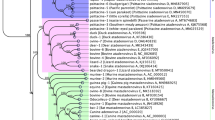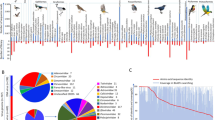Abstract
Polyomavirus infections were detected in 40 companion bird individuals belonging to a broad species range of estrildid and fringillid finches and originating from 21 different bird aviaries. Based on partial virus protein 1 (VP1) sequences, the viruses were identified as Serinus canaria polyomavirus 1 and Pyrrhula pyrrhula polyomavirus 1. Serinus canaria polyomavirus 1 was found in 18 birds belonging to one estrildid and four fringillid species. Pyrrhula pyrrhula polyomavirus 1 was detected in 22 birds of six estrildid and three fringillid species. There was a large overlap in host range. Increased mortality was frequently found in the affected bird aviaries while clinical signs were diverse. Co-infections with other viruses, bacteria or fungal pathogens were common and might have influenced the clinical signs. Sequence analyses, including partial VP1 sequences of the 40 virus strains, and full genome sequences of selected strains revealed a high genetic heterogeneity among virus subgroups of Serinus canaria polyomavirus 1 and Pyrrhula pyrrhula polyomavirus 1, indicating the existence of two virus variants for both virus species. For Pyrrhula pyrrhula polyomavirus 1, two genotypes were found that associated with the family of the finches, Estrildidae or Fringillidae.


Similar content being viewed by others
References
Johne R, Buck CB, Allander T, Atwood WJ, Garcea RL, Imperiale MJ, Major EO, Ramqvist T, Norkin LC (2011) Taxonomical developments in the family Polyomaviridae. Arch Virol 156(9):1627–1634. https://doi.org/10.1007/s00705-011-1008-x
Peretti A, FitzGerald PC, Bliskovsky V, Pastrana DV, Buck CB (2015) Genome sequence of a fish-associated polyomavirus, Black Sea Bass (Centropristis striata) Polyomavirus 1. Genome announcements. https://doi.org/10.1128/genomeA.01476-14
Dill JA, Ng TF, Camus AC (2016) Complete sequence of the smallest polyomavirus genome, Giant Guitarfish (Rhynchobatus djiddensis) polyomavirus 1. Genome announcements. https://doi.org/10.1128/genomeA.00391-16
Buck CB, Van Doorslaer K, Peretti A, Geoghegan EM, Tisza MJ, An P, Katz JP, Pipas JM, McBride AA, Camus AC, McDermott AJ, Dill JA, Delwart E, Ng TF, Farkas K, Austin C, Kraberger S, Davison W, Pastrana DV, Varsani A (2016) The ancient evolutionary history of polyomaviruses. PLoS Pathog 12(4):e1005574. https://doi.org/10.1371/journal.ppat.1005574
Norkin LC (2010) Virology: molecular biology and pathogenesis. ASM Press, Washington, DC
Forshaw D, Wylie SL, Pass DA (1988) Infection with a virus resembling papovavirus in Gouldian finches (Erythrura gouldiae). Aust Vet J 65(1):26–28
Sironi G, Rampin T (1987) Spleno-epatopatia da virus papova-simile nei verdone (Carduelis chloris). Clin Vet 110(1):79–82
Sironi G (1988) Dual poxvirus and papova-like virus pneumonia in canary (Serinus canarius). Clin Vet 111(1–2):61–67
Sironi G (1991) Concurrent papovavirus-like and atoxoplasma infections in a goldfinch (Carduelis carduelis). Avian Pathol 20(4):725–729. https://doi.org/10.1080/03079459108418812
Fitzgerald SD, Williams SM, Reed WM (1996) Development of a chicken model for studying avian polyomavirus infection. Avian Dis 40(2):377–381
Shivaprasad HL (2009) Polyomavirus infection in canaries. In: Bergman E (ed) Annual conference of the association of avian veterinarians, Milwaukee, WI, pp 65–66
Shivaprasad HL, Kim T, Tripathy D, Woolcock PR, Uzal F (2009) Unusual pathology of canary poxvirus infection associated with high mortality in young and adult breeder canaries (Serinus canaria). Avian Pathol 38(4):311–316. https://doi.org/10.1080/03079450903061643
Johnston KM, Riddell C (1986) Intranuclear inclusion bodies in finches. Can Vet J 27(11):432–434
Marshall R (1989) Papova-like virus in a finch aviary. In: Wells S (ed) Annual conference of the association of avian veterinarians, Seattle, WA, pp 203–207
Woods LW (1989) Case report: papova-like virus in a painted finch. In: Wells S (ed) Annual conference of the association of avian veterinarians, Seattle, WA, pp 218–219
Bauck L, Brash M (1990) Survey of diseases of the Lady Gouldian finch. In: Bergman E (ed) Annual conference of the association of avian veterinarians, Phoenix, AZ, pp 204–212
Garcia A, Latimer KS, Niagro FD, Norton TM, Campagnoli RP, Harmon BG, Howerth EW, Ritchie BW (1994) Diagnosis of polyomavirus infection in seedcrackers (Pyrenestes sp.) and blue bills (Spermophaga haematina) using DNA in situ hybridization. Avian Pathol 23(3):525–537. https://doi.org/10.1080/03079459408419022
Garcia A, Latimer KS, Niagro FD, Norton TM, Harmon BG, Campagnoli RP, Steffens WL 3rd (1993) Avian polyomavirus infection in three Black-bellied seed crackers (Pyrenestes ostrinus). J Assoc Avian Vet 7(2):79–82
Rossi G, Ceccherelli R, Piersigilli A, Tarantino C (2003) Sertoli cell tumor associated with polyomavirus infection in a Gouldian finch (Erythrura gouldiae). Avian Dis 47(1):240–243. https://doi.org/10.1637/0005-2086(2003)047[0240:sctawp]2.0.co;2
Sandmeier P, Gerlach H, Johne R, Muller H (1999) Polyomavirus infections in exotic birds in Switzerland. Schweiz Arch Tierheilkd 141(5):223–229
Rossi G, Taccini E, Tarantino C (2005) Outbreak of avian polyomavirus infection with high mortality in recently captured Crimson’s seedcrackers (Pyrenestes sanguineus). J Wildl Dis 41(1):236–240. https://doi.org/10.7589/0090-3558-41.1.236
Johne R, Wittig W, Fernandez-de-Luco D, Hofle U, Muller H (2006) Characterization of two novel polyomaviruses of birds by using multiply primed rolling-circle amplification of their genomes. J Virol 80(7):3523–3531. https://doi.org/10.1128/jvi.80.7.3523-3531.2006
Manarolla G, Liandris E, Pisoni G, Moroni P, Piccinini R, Rampin T (2007) Mycobacterium genavense and avian polyomavirus co-infection in a European goldfinch (Carduelis carduelis). Avian Pathol 36(5):423–426. https://doi.org/10.1080/03079450701598390
Wittig W, Hoffmann K, Muller H, Johne R (2007) Detection of DNA of the finch polyomavirus in diseases of various types of birds in the order Passeriformes. Berl Munch Tierarztl Wochenschr 120(3–4):113–119
Alley MR, Rasiah I, Lee EA, Howe L, Gartrell BD (2013) Avian polyomavirus identified in a nestling Gouldian finch (Erythrura gouldiae) in New Zealand. N Z Vet J 61(6):359–361. https://doi.org/10.1080/00480169.2012.760393
Marton S, Erdelyi K, Dan A, Banyai K, Feher E (2016) Complete genome sequence of a variant Pyrrhula pyrrhula polyomavirus 1 strain isolated from white-headed Munia (Lonchura maja). Genome Announcements. https://doi.org/10.1128/genomeA.01172-16
Halami MY, Dorrestein GM, Couteel P, Heckel G, Muller H, Johne R (2010) Whole-genome characterization of a novel polyomavirus detected in fatally diseased canary birds. J Gen Virol 91(Pt 12):3016–3022. https://doi.org/10.1099/vir.0.023549-0
Heenemann K, Sieg M, Rueckner A, Vahlenkamp TW (2015) Complete genome sequence of a novel avian polyomavirus isolated from Gouldian Finch. Genome Announc. https://doi.org/10.1128/genomeA.01001-15
Calvignac-Spencer S, Feltkamp MC, Daugherty MD, Moens U, Ramqvist T, Johne R, Ehlers B (2016) A taxonomy update for the family Polyomaviridae. Arch Virol 161(6):1739–1750. https://doi.org/10.1007/s00705-016-2794-y
Halami MY, Nieper H, Muller H, Johne R (2008) Detection of a novel circovirus in mute swans (Cygnus olor) by using nested broad-spectrum PCR. Virus Res 132(1–2):208–212. https://doi.org/10.1016/j.virusres.2007.11.001
Ehricht R, Slickers P, Goellner S, Hotzel H, Sachse K (2006) Optimized DNA microarray assay allows detection and genotyping of single PCR-amplifiable target copies. Mol Cell Probes 20(1):60–63. https://doi.org/10.1016/j.mcp.2005.09.003
Michels J (2014) Entwicklung einer realtime-polymerase-Kettenreaktion zum Nachweis von Mycobacterium genavense beim Vogel. Inaug. Dissertation, LMU München
Wellehan JF, Johnson AJ, Harrach B, Benko M, Pessier AP, Johnson CM, Garner MM, Childress A, Jacobson ER (2004) Detection and analysis of six lizard adenoviruses by consensus primer PCR provides further evidence of a reptilian origin for the atadenoviruses. J Virol 78(23):13366–13369. https://doi.org/10.1128/jvi.78.23.13366-13369.2004
VanDevanter DR, Warrener P, Bennett L, Schultz ER, Coulter S, Garber RL, Rose TM (1996) Detection and analysis of diverse herpesviral species by consensus primer PCR. J Clin Microbiol 34(7):1666–1671
Kistler AL, Gancz A, Clubb S, Skewes-Cox P, Fischer K, Sorber K, Chiu CY, Lublin A, Mechani S, Farnoushi Y, Greninger A, Wen CC, Karlene SB, Ganem D, DeRisi JL (2008) Recovery of divergent avian bornaviruses from cases of proventricular dilatation disease: identification of a candidate etiologic agent. Virol J 5:88. https://doi.org/10.1186/1743-422x-5-88
Varsani A, Porzig EL, Jennings S, Kraberger S, Farkas K, Julian L, Massaro M, Ballard G, Ainley DG (2015) Identification of an avian polyomavirus associated with Adelie penguins (Pygoscelis adeliae). J Gen Virol 96(Pt 4):851–857. https://doi.org/10.1099/vir.0.000038
Ehlers B, Moens U (2014) Genome analysis of non-human primate polyomaviruses. Infect Genet Evol 26:283–294. https://doi.org/10.1016/j.meegid.2014.05.030
Sigrist CJ, Cerutti L, Hulo N, Gattiker A, Falquet L, Pagni M, Bairoch A, Bucher P (2002) PROSITE: a documented database using patterns and profiles as motif descriptors. Brief Bioinf 3(3):265–274
Edgar RC (2004) MUSCLE: multiple sequence alignment with high accuracy and high throughput. Nucl Acids Res 32(5):1792–1797. https://doi.org/10.1093/nar/gkh340
Tamura K, Stecher G, Peterson D, Filipski A, Kumar S (2013) MEGA6: molecular evolutionary genetics analysis version 6.0. Mol Biol Evol 30(12):2725–2729. https://doi.org/10.1093/molbev/mst197
Saitou N, Nei M (1987) The neighbor-joining method: a new method for reconstructing phylogenetic trees. Mol Biol Evol 4(4):406–425
Tamura K, Nei M, Kumar S (2004) Prospects for inferring very large phylogenies by using the neighbor-joining method. Proc Natl Acad Sci USA 101(30):11030–11035. https://doi.org/10.1073/pnas.0404206101
Nei M, Kumar S (2000) Molecular evolution and phylogenetics. Oxford University Press, Oxford
Felsenstein J (1995) Confidence limits on phylogenies: an approach using the bootstrap. Evolution 39:783–791
Johne R, Muller H (2007) Polyomaviruses of birds: etiologic agents of inflammatory diseases in a tumor virus family. J Virol 81(21):11554–11559. https://doi.org/10.1128/jvi.01178-07
Johne R, Muller H (1998) Avian polymavirus in wild birds: genome analysis of isolates from Falconiformes and Psittaciformes. Arch Virol 143(8):1501–1512
Johne R, Raue R, Krautwald-Junghanns M-E, Müller H (2003) Papillomvirus- und Polyomavirus-Infektionen bei Zier- und Wildvögeln: eine Übersicht. Tierärztliche Praxis Kleintiere 31(3):188–193
Stoll R, Luo D, Kouwenhoven B, Hobom G, Muller H (1993) Molecular and biological characteristics of avian polyomaviruses: isolates from different species of birds indicate that avian polyomaviruses form a distinct subgenus within the polyomavirus genus. J Gen Virol 74(Pt 2):229–237. https://doi.org/10.1099/0022-1317-74-2-229
Arroube AS, Halami MY, Johne R, Dorrestein GM (2009) Mortality due to polyomavirus infection in two nightjars (Caprimulgus europaeus). J Avian Med Surg 23(2):136–140. https://doi.org/10.1647/2008-007.1
Lafferty SL, Fudge AM, Schmidt RE, Wilson VG, Phalen DN (1999) Avian polyomavirus infection and disease in a green aracaris (Pteroglossus viridis). Avian Dis 43(3):577–585
Dayaram A, Piasecki T, Chrzastek K, White R, Julian L, van Bysterveldt K, Varsani A (2015) Avian polyomavirus genome sequences recovered from parrots in captive breeding facilities in Poland. Genome Announc. https://doi.org/10.1128/genomeA.00986-15
Jin L, Gibson PE, Booth JC, Clewley JP (1993) Genomic typing of BK virus in clinical specimens by direct sequencing of polymerase chain reaction products. J Med Virol 41(1):11–17
Stoner GL, Jobes DV, Fernandez Cobo M, Agostini HT, Chima SC, Ryschkewitsch CF (2000) JC virus as a marker of human migration to the Americas. Microb Infect 2(15):1905–1911
Zanotta N, Delbue S, Rossi T, Pelos G, D’Agaro P, Monasta L, Ferrante P, Comar M (2013) Molecular epidemiology of JCV genotypes in patients and healthy subjects from Northern Italy. J Med Virol 85(7):1286–1292. https://doi.org/10.1002/jmv.23585
Ritchie BW, Niagro FD, Latimer KS, Davis RB, Pesti D, Lukert PD (1991) Avian polyomavirus: an overview. J Am Assoc Vet 5(3):147–153
Schmidt RE, Reavill DR, Phalen DN (2015) Pathology of pet and aviary birds, 2nd edn. Wiley, Hoboken
Acknowledgements
We would like to thank Lisa Koch, Dana Härtner and Miriam Schiller for technical assistance.
Author information
Authors and Affiliations
Corresponding author
Ethics declarations
Conflict of interest
The authors declare that they have no conflict of interest.
Funding
There was no external funding of the project.
Ethical approval
All applicable international, national, and/or institutional guidelines for the care and use of animals were followed. This article does not contain any studies with human participants performed by any of the authors.
Additional information
Handling Editor: Diego G. Diel.
Rights and permissions
About this article
Cite this article
Rinder, M., Schmitz, A., Peschel, A. et al. Identification and genetic characterization of polyomaviruses in estrildid and fringillid finches. Arch Virol 163, 895–909 (2018). https://doi.org/10.1007/s00705-017-3688-3
Received:
Accepted:
Published:
Issue Date:
DOI: https://doi.org/10.1007/s00705-017-3688-3




